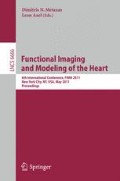Abstract
In coronary angiography, a catheter’s tip has to be directed through the aorta towards the ostium – the region where the coronary arteries arise. Due to the anatomical variation in different humans, there is no common catheter which can be used for all patients. Thus, in a trial and error procedure cardiologists find a catheter that fits to the patient’s anatomy. To replace this time consuming approach by providing a computer aided planning tool to be used prior to the intervention is the focus of our work. First of all, it is necessary for such a system to derive geometrical parameters for the patient’s aorta as well as for the different available catheters. Based thereon, the best fitting catheter can be selected. In this paper, we discuss the first step: the computation of geometrical parameters from the patient’s image data. Due to the setting defined by our clinical partner, two MRI data sets are acquired and should be used for the computation. This requires a specific image processing pipeline which we present here and which has to our knowledge not been proposed so far. Furthermore, we show first results obtained for real clinical data sets and discuss the subsequent steps for the development of the catheter selection tool.
Access this chapter
Tax calculation will be finalised at checkout
Purchases are for personal use only
Preview
Unable to display preview. Download preview PDF.
References
Sarkar, K., Sharma, S., Kini, A.: Catheter Selection for Coronary Angiography and Intervention in Anomalous Right Coronary Arteries. Journal of Interventional Cardiology 22, 234–239 (2009)
Kimbiris, D., Iskandrian, A., Segal, B., Bemis, C.: Anomalous Aortic Origin of Coronary Arteries. Circulation 58(4), 606–615 (1978)
Brinkman, A., Baker, P., Newman, W., Vigorito, R., Friedman, M.: Variability of human coronary artery geometry: An angiographic study of the left anterior descending arteries of 30 autopsy hearts. Annals of Biomedical Engineering 22, 34–44 (1994), 10.1007/BF02368220
Myler, R., Boucher, R., Cumberland, D., Stertzer, S.: Guiding catheter selection for right coronary artery angioplasty. Catheterization and Cardiovascular Diagnosis 19 (1990)
Schneider, P.: Endovascular Skills: Guidewire and Catheter Skills for Endovascular Surgery, 2nd edn. Marcel Dekkar Inc., New York (2003)
Rueckert, D., Burger, P., Forbat, S., Mohiaddin, R., Yang, G.: Automatic tracking of the aorta in cardiovascular MR images using deformable models. IEEE Transactions on Medical Imaging 16(5), 581–590 (1997)
Kovács, T., Cattin, P., Alkadhi, H., Wildermuth, S., Székely, G.: Automatic Segmentation of the Vessel Lumen from 3D CTA Images of Aortic Dissection. In: Brauer, W., Handels, H., Ehrhardt, J., Horsch, A., Meinzer, H.P., Tolxdorff, T. (eds.) Bildverarbeitung für die Medizin 2006. Informatik aktuell, pp. 161–165. Springer, Heidelberg (2006)
Kovács, T., Cattin, P.C., Alkadhi, H., Wildermuth, S., Székely, G.: Automatic segmentation of the aortic dissection membrane from 3D CTA images. In: Yang, G.-Z., Jiang, T.-Z., Shen, D., Gu, L., Yang, J. (eds.) MIAR 2006. LNCS, vol. 4091, pp. 317–324. Springer, Heidelberg (2006)
Wörz, S., Rohr, K.: Segmentation and Quantification of Human Vessels Using a 3-D Cylindrical Intensity Model. IEEE Transactions on Image Processing 16(8), 1994–2004 (2007)
Wörz, S., von Tengg-Kobligk, H., Henninger, V., Rengier, F., Schumacher, H., Böckler, D., Kauczor, H.U., Rohr, K.: 3-D Quantification of the Aortic Arch Morphology in 3-D CTA Data for Endovascular Aortic Repair. IEEE Transactions on Biomedical Engineering 57(10), 2359–2368 (2010)
Saur, S., Kühnel, C., Boskamp, T., Székely, G.: Automatic Ascending Aorta Detection in CTA Datasets (2008)
Lorenz, C., Renisch, S., Schlathoelter, T., Buelow, T.: Simultaneous segmentation and tree reconstruction of the coronary arteries in MSCT images. SPIE, vol. 5031, pp. 167–177 (2003)
Hennemuth, A., Boskamp, T., Fritz, D., Kühnel, C., Bock, S., Rinck, D., Scheuering, M., Peitgen, H.O.: One-click coronary tree segmentation in CT angiographic images. International Congress Series 1281, 317–321 (2005); CARS 2005: Computer Assisted Radiology and Surgery
Fallavollita, P., Cheriet, F.: Towards an Automatic Coronary Artery Segmentation Algorithm. In: 28th Annual International Conference of the IEEE Engineering in Medicine and Biology Society, EMBS 2006 (30, 2006)
Wang, Y., Liatsis, P.: A Fully Automated Framework for Segmentation and Stenosis Quantification of Coronary Arteries in 3D CTA Imaging. In: 2009 Second International Conference on Developments in eSystems Engineering (DESE), pp. 136–140 (2009)
Shoujun, Z., Jian, Y., Yongtian, W., Wufan, C.: Automatic segmentation of coronary angiograms based on fuzzy inferring and probabilistic tracking. BioMedical Engineering OnLine 9(1), 40 (2010)
Ballard, D.: Generalizing the Hough transform to detect arbitrary shapes. Pattern Recognition 13(2), 111–122 (1981)
Sethian, J.: Fast Marching Methods. SIAM Rev. 41, 199–235 (1999)
Frangi, A., Niessen, W., Hoogeveen, R., van Walsum, T., Viergever, M.: Quantitation of Vessel Morphology from 3D MRA. In: Taylor, C., Colchester, A. (eds.) MICCAI 1999. LNCS, vol. 1679, pp. 358–367. Springer, Heidelberg (1999)
Homann, H.: Implementation of a 3D thinning algorithm. Oxford University, Wolfson Medical Vision Lab. (2007)
Rahman, S.U., Wesarg, S., Völker, W.: Patient Specific Optimal Catheter Selection for Right Coronary Artery, SPIE Medical Imaging (to appear, 2011)
Author information
Authors and Affiliations
Editor information
Editors and Affiliations
Rights and permissions
Copyright information
© 2011 Springer-Verlag Berlin Heidelberg
About this paper
Cite this paper
Flehmann, E., Rahman, S.u., Wesarg, S., Voelker, W. (2011). Towards Patient Specific Catheter Selection: Computation of Aortic Geometry Based on Fused MRI Data. In: Metaxas, D.N., Axel, L. (eds) Functional Imaging and Modeling of the Heart. FIMH 2011. Lecture Notes in Computer Science, vol 6666. Springer, Berlin, Heidelberg. https://doi.org/10.1007/978-3-642-21028-0_18
Download citation
DOI: https://doi.org/10.1007/978-3-642-21028-0_18
Publisher Name: Springer, Berlin, Heidelberg
Print ISBN: 978-3-642-21027-3
Online ISBN: 978-3-642-21028-0
eBook Packages: Computer ScienceComputer Science (R0)

